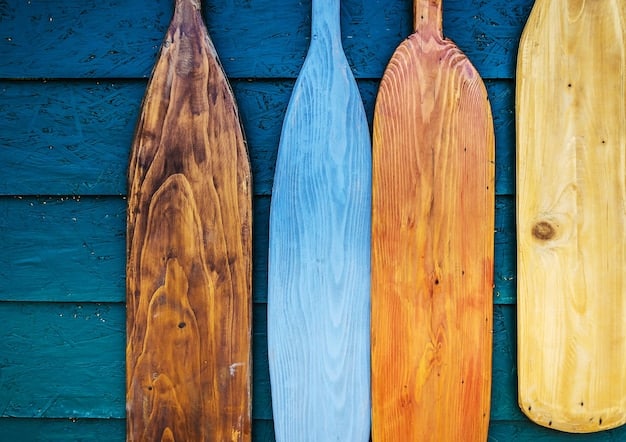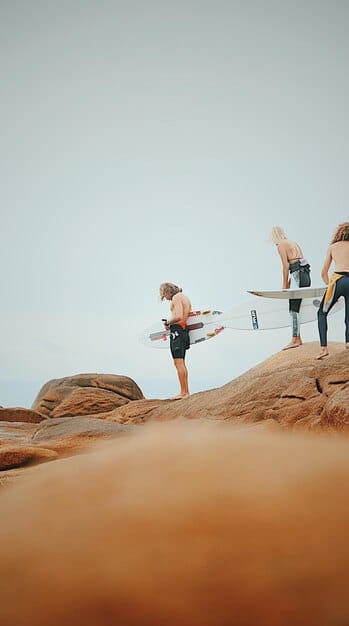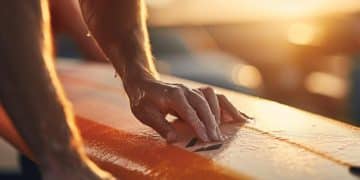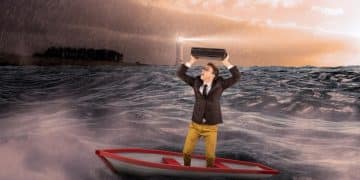Learn to Surf: Your Step-by-Step Beginner’s Guide

Learn to surf with this comprehensive guide designed for beginners, providing step-by-step instructions on everything from choosing the right equipment and understanding ocean conditions to mastering the pop-up and catching your first wave, ensuring a safe and exhilarating introduction to the sport.
Are you dreaming of riding your first wave but don’t know where to start? This guide will **learn to surf: a step-by-step guide for beginners to catch their first wave**, providing you with all the essential knowledge and techniques to get you up and surfing safely and confidently.
Choosing the Right Surfboard for Beginners
Selecting the right surfboard is crucial for beginner surfers. A board that’s too small or difficult to handle can lead to frustration and slow down the learning process. Understanding the different types of surfboards and their characteristics will help you make an informed decision.
Surfboard Size and Volume
For beginners, a larger surfboard is generally better. Look for a board that’s long, wide, and thick, as this will provide more stability and make it easier to paddle and catch waves. Volume, measured in liters, is another important factor. Higher volume means more buoyancy, which translates to easier paddling and wave-catching.
Types of Surfboards
Soft-top surfboards, also known as foam boards, are an excellent choice for beginners. These boards are made of soft foam, making them more forgiving in case of collisions. They are also typically more affordable than hard-top boards. Another option is a longboard, which offers exceptional stability and is ideal for small to medium-sized waves.
- Soft-top (Foam) Boards: Ideal for initial learning, forgiving, and safer for beginners.
- Longboards: Provide stability and easy paddling, suitable for small to medium waves.
- Hybrid Boards: A balance between longboards and shortboards, offering maneuverability with some stability.

Choosing the right surfboard also involves considering your weight and height. A surf shop employee can provide personalized recommendations based on your physical attributes. Renting a few different boards before making a purchase is a great way to test out different shapes and sizes to see what feels most comfortable.
In conclusion, selecting the right surfboard as a beginner involves considering size, volume, and board type. Soft-top and longboards are excellent choices for initial learning, providing the stability and buoyancy needed to catch your first waves.
Understanding Ocean Conditions and Safety
Before you even step foot in the water, it’s essential to understand ocean conditions and safety. Surfing can be dangerous if you’re not aware of potential hazards and how to avoid them. Learning about tides, currents, and weather patterns will help you make informed decisions and stay safe while surfing.
Tides and Currents
Tides and currents can significantly impact surfing conditions. High tide can make waves break closer to shore, while low tide might expose rocks and reefs. Rip currents, strong currents flowing away from the shore, are a major hazard. Learn how to identify rip currents and how to escape them by swimming parallel to the shore.
Weather and Surf Forecasts
Checking the weather and surf forecasts before heading to the beach is crucial. Look for information on wave height, wind direction, and swell period. Understanding these factors will help you choose the right location and time to surf. Pay attention to any warnings or advisories issued by local authorities.
Before hitting the waves, take precautions. Understand the location you’re surfing in – are there hazards? Are there a lot of other surfers? Never surf alone, and always inform someone of your plans. Make sure you have the right safety equipment and that you know how to use it.
- Identify Rip Currents: Look for breaks in the wave pattern or discolored water.
- Check Weather Forecasts: Note wave height, wind, and swell period.
- Never Surf Alone: Always have a buddy.
Being aware of your surroundings and understanding ocean conditions is paramount for surfer safety. By learning to identify potential hazards such as rip currents and checking weather forecasts you can minimize risks and enjoy a safe and rewarding surfing experience. Taking a surf lesson and asking a local surfer about any potential spots to avoid is also key.
Mastering the Pop-Up Technique
The pop-up is the technique of transitioning from lying on your stomach to standing on the board. It’s a fundamental skill that requires practice and coordination. Mastering the pop-up will allow you to ride waves with confidence and control.
Step-by-Step Pop-Up Guide
Start by lying on your stomach on the surfboard, positioning yourself towards the front of the board. Place your hands flat on the board, roughly shoulder-width apart, near your chest. Push up onto your hands, arching your back slightly. Bring your feet forward, placing them between your hands. Stand up quickly, keeping your knees bent and your weight centered.
Practice on Land
Before attempting the pop-up in the water, practice on land. This will help you develop muscle memory and refine your technique. Use a soft surface, such as a carpet or grass, to cushion your fall. Repeat the pop-up several times a day until it feels natural and fluid.

Pop-up practice can be made easier with a few tricks to try. For example, try using a line on the surf board for your hands to push off and your feet to land. Enlisting the help of a surfing coach who can provide direct feedback is another great approach to improving your pop-up technique.
- Practice Regularly: Consistency is key to developing muscle memory.
- Use Visual Aids: Watch videos and tutorials to refine your technique.
- Seek Feedback: Ask experienced surfers or instructors for advice.
Achieving a fluid pop-up requires consistent practice and a focus on technique. Practicing on land helps to develop muscle memory. With dedication and the right guidance, you’ll be standing up and riding waves in no time at all.
Paddling Effectively and Catching Waves
Paddling is an essential skill for surfers. Effective paddling allows you to position yourself correctly, catch waves, and conserve energy. Learning the proper technique will help you maximize your paddling power and efficiency.
Correct Paddling Technique
Lie on your stomach on the surfboard, positioning yourself towards the front of the board. Keep your back arched slightly and your head up, looking ahead. Use long, smooth strokes, reaching forward as far as possible. Pull your hands through the water with a cupping motion, keeping your elbows high. Alternate strokes smoothly and rhythmically.
Positioning for Waves
Positioning yourself correctly is crucial for catching waves. Paddle towards the peak of the wave, angling slightly to avoid being caught in the whitewash. Watch other surfers to see where they are positioning themselves and adjust accordingly. Pay attention to the wave’s shape and direction, and paddle to intercept it at the optimal point.
There are common mistakes that beginner surfers often make when learning how to paddle, such as paddling too slow, not leaning into their board enough, or improperly feathering the water. These things can be identified and coached.
- Maintain Proper Posture: Keep your back arched and head up.
- Paddle with Long Strokes: Maximize each stroke by reaching forward.
- Angle Towards the Peak: Position yourself to intercept the wave at its highest point.
By mastering the correct paddling technique and learning to position yourself effectively, you’ll be able to catch more waves and enjoy a more rewarding surfing experience. Remember to practice regularly and adjust your technique based on the conditions.
Riding Your First Wave: Stance and Balance
Once you’ve popped up and are riding a wave, maintaining proper stance and balance is essential for control and stability. Your stance will depend on your preference, but most surfers ride either regular (left foot forward) or goofy (right foot forward). Finding your natural stance and practicing your balance will help you stay on the board and enjoy the ride.
Finding Your Stance
To determine your stance, try having someone gently push you from behind while you’re standing with your feet together. The foot you naturally step forward with is likely your lead foot. Alternatively, you can try sliding on a slippery floor or riding a skateboard to see which foot feels more comfortable in front. This is not a perfect science and you may want to practice in both directions, but this should provide a basic starting point for you.
Maintaining Balance
Keep your knees bent and your weight centered over the board. Use your arms for balance, extending them out to the sides. Look in the direction you want to go, and shift your weight slightly to steer. Avoid leaning too far forward or backward, as this can cause you to lose control.
Practice makes perfect when it comes to maintaining balance. There are a few tricks that you can introduce to improve the sense of balance that you develop. Yoga and exercises that are done on balance boards are two ways to improve, but the only way to properly hone your balance and form is through persistent practice.
- Bend Your Knees: Lower your center of gravity for better stability.
- Use Your Arms: Extend your arms for balance and control.
- Look Where You Want to Go: Steer by shifting your weight and focusing on your target.
Mastering your stance and learning to maintain balance are critical for a positive surfing experience. These skills will allow you to confidently progress as a surfer.
Etiquette and Respect in the Water
Surfing etiquette is a set of unwritten rules that promote safety and respect in the water. Following these guidelines will help ensure that everyone has a positive experience. Respect for other surfers and the ocean environment is essential for maintaining a harmonious surfing community.
Right of Way
The surfer closest to the peak of the wave has the right of way. This means that other surfers should not paddle in front of them or drop in on their wave. If two surfers are paddling for the same wave, the surfer who is deeper (closer to the peak) has priority.
Respecting Other Surfers
Avoid dropping in on other surfers by paddling in front of them to steal their wave. After you’ve finished riding a wave, paddle wide and out of the way of other surfers. Be mindful of your board, and avoid letting it hit other people. Communicate with other surfers and be courteous and respectful.
When it comes to etiquette while you surf also consider how you interact with the location. Are there marine animals nearby? Are you being considerate of the local habitat?
- Don’t Drop In: Avoid paddling in front of another surfer who is already riding the wave.
- Paddle Wide: After riding a wave, paddle away from the lineup to avoid interfering with other surfers.
- Communicate: Be courteous and respectful to other surfers.
Surfing etiquette plays a crucial role in maintaining the safety and overall enjoyment of the waves and the ocean. By understanding and adhering to these guidelines, you contribute to a positive and harmonious surfing community.
| Key Point | Brief Description |
|---|---|
| 🏄 Surfboard Choice | Beginners should opt for soft-top or longboards for stability. |
| 🌊 Ocean Safety | Understand tides, currents, and weather before surfing. Never surf alone. |
| ⬆️ Pop-Up | Practice the pop-up technique on land to build muscle memory. |
| 🤝 Surfing Etiquette | Respect the right of way and be considerate of other surfers. |
Frequently Asked Questions
▼
Beginners should start with a larger board, such as a soft-top or longboard, for increased stability. Look for boards that are at least 8 feet long and have high volume (over 60 liters) to help with paddling and catching waves.
▼
Rip currents often appear as breaks in the wave pattern, discolored water, or a channel of choppy water flowing away from the shore. If caught in a rip current, swim parallel to the shore until you’re out of the current, then swim back to shore.
▼
Learning to surf varies depending on individual ability, physical fitness, and dedication. Some people can stand up and ride waves on their first lesson, while others may need several lessons to get the hang of it. Consistent practice is key to improvement.
▼
The best time to surf often depends on the local conditions. Early mornings are frequently preferred, as winds tend to be calmer. However, checking local surf forecasts and observing tide changes will help determine the optimal time for your location.
▼
Wear appropriate attire based on water temperature. A wetsuit is recommended for colder water, while a rash guard and board shorts are suitable for warmer conditions. Always wear sunscreen and consider a hat to protect yourself from the sun.
Conclusion
Embarking on the journey to learn to surf is an exciting endeavor that combines physical skill, understanding of the ocean, and respect for fellow surfers. By following this step-by-step guide, you’ll be well-equipped to catch your first wave and continue progressing in this exhilarating sport. Remember to prioritize safety, respect the ocean, and most importantly, have fun!





